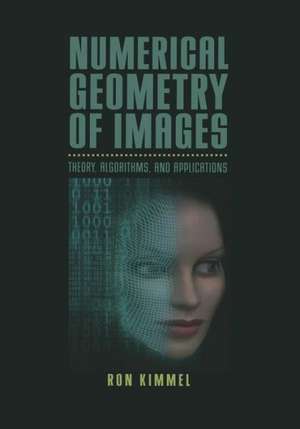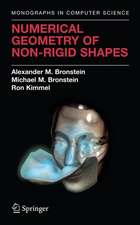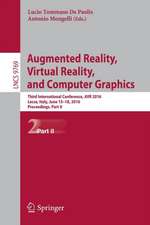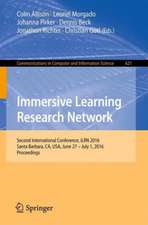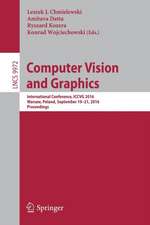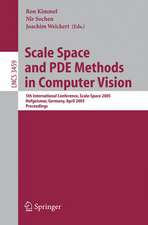Numerical Geometry of Images: Theory, Algorithms, and Applications
Autor Ron Kimmel Ilustrat de M. Bronstein, A. Bronsteinen Limba Engleză Paperback – 31 aug 2012
| Toate formatele și edițiile | Preț | Express |
|---|---|---|
| Paperback (1) | 326.04 lei 6-8 săpt. | |
| Springer – 31 aug 2012 | 326.04 lei 6-8 săpt. | |
| Hardback (1) | 319.59 lei 39-44 zile | |
| Springer – 31 oct 2003 | 319.59 lei 39-44 zile |
Preț: 326.04 lei
Preț vechi: 407.55 lei
-20% Nou
Puncte Express: 489
Preț estimativ în valută:
62.43€ • 65.00$ • 51.79£
62.43€ • 65.00$ • 51.79£
Carte tipărită la comandă
Livrare economică 13-27 februarie
Preluare comenzi: 021 569.72.76
Specificații
ISBN-13: 9781468495355
ISBN-10: 1468495356
Pagini: 224
Ilustrații: XIII, 209 p. 254 illus.
Dimensiuni: 178 x 254 x 12 mm
Greutate: 0.4 kg
Ediția:Softcover reprint of the original 1st ed. 2004
Editura: Springer
Colecția Springer
Locul publicării:New York, NY, United States
ISBN-10: 1468495356
Pagini: 224
Ilustrații: XIII, 209 p. 254 illus.
Dimensiuni: 178 x 254 x 12 mm
Greutate: 0.4 kg
Ediția:Softcover reprint of the original 1st ed. 2004
Editura: Springer
Colecția Springer
Locul publicării:New York, NY, United States
Public țintă
Professional/practitionerCuprins
1 Introduction.- 1.1 Mathematical Tools and Machinery.- 1.2 Applications.- 1.3 Exercises.- 2 Basic Differential Geometry.- 2.1 Introduction to Differential Geometry in the Plane.- 2.2 Invariant Signatures.- 2.3 Calculus of Variations in Parametric Form.- 2.4 Geometry of Surfaces.- 2.5 A Brief Introduction to Intrinsic Geometry.- 2.6 Exercises.- 3 Curve and Surface Evolution.- 3.1 Evolution.- 3.2 Properties of Curve Evolution.- 3.3 Surface Evolution.- 3.4 Exercises.- 4 The Osher—Sethian Level Set Method.- 4.1 The Eulerian Formulation.- 4.2 From Curve to Image Evolution.- 4.3 Exercises.- 5 The Level Set Method: Numerical Considerations.- 5.1 Finite Difference Approximation.- 5.2 Conservation Laws and Hamilton-Jacobi Equations.- 5.3 Entropy Condition and Vanishing Viscosity.- 5.4 Numerical Methodologies.- 5.5 The CFL Condition.- 5.6 One-Dimensional Example of a Differential Conservation Law.- 5.7 Two-Dimensional Example of the CFL Condition.- 5.8 Viscosity Solutions.- 5.9 Summary.- 5.10 Exercises.- 6 Mathematical Morphology and Distance Maps.- 6.1 Continuous Morphology by Curve Evolution.- 6.2 Continuous-Scale Morphology.- 6.3 Distance Maps.- 6.4 Skeletons.- 6.5 Exercises.- 7 Fast Marching Methods.- 7.1 The One-Dimensional Eikonal Equation.- 7.2 Fast Marching on Two-Dimensional Rectangular Grids.- 7.3 Fast Marching on Triangulated Manifolds.- 7.4 Applications of Fast Marching on Surfaces.- 7.5 Exercises.- 8 Shape from Shading.- 8.1 Problem Formulation.- 8.2 Horn Characteristic Strip Expansion Method.- 8.3 Bruckstein’s Equal-Height Contours Expansion Method.- 8.4 Tracking Level Sets by Level Sets.- 8.5 Extracting the Surface Topography.- 8.6 Oblique Light Source.- 8.7 Summary.- 8.8 Exercises.- 9 2D and 3D Image Segmentation.- 9.1 The Level Set Geometric Model.- 9.2Geodesic Active Contours.- 9.3 Relation to Image Enhancement Methods.- 9.4 Nongeometric Measures and the Maupertuis Principle of Least Action.- 9.5 Edge Integration.- 9.6 Geometric Segmentation in 3D.- 9.7 Efficient Numerical Schemes.- 9.8 Exercises.- 10 Geometric Framework in Image Processing.- 10.1 Images as Surfaces.- 10.2 The Geometric Framework.- 10.3 Movies and Volumetric Medical Images.- 10.4 The Image Area as a Measure for Color Processing.- 10.5 The Metric as a Structure Tensor.- 10.6 Inverse Diffusion Across the Edge.- 10.7 Summary.- 10.8 Exercises.- 11 Texture Mapping, Matching Isometric Surfaces, and 3D Face Recognition.- 11.1 Flat Embedding.- 11.2 Texture Mapping.- 11.3 Isometric Signatures for Surfaces.- 11.4 Face Recognition.- 11.5 Exercises.- 12 Solutions to Selected Problems.
Recenzii
From the reviews:
"After a brief introduction to differential geometry the book covers computational methods and algorithms in image processing and image analysis. … The author presents classic approaches as well as new solutions … . It would certainly be beneficial for the presumptive reader to be able to rely on a sound background in geometry, linear algebra and calculus." (Anton Gfrerrer, Zentralblatt MATH, Vol. 1049, 2004)
"After a brief introduction to differential geometry the book covers computational methods and algorithms in image processing and image analysis. … The author presents classic approaches as well as new solutions … . It would certainly be beneficial for the presumptive reader to be able to rely on a sound background in geometry, linear algebra and calculus." (Anton Gfrerrer, Zentralblatt MATH, Vol. 1049, 2004)
Textul de pe ultima copertă
With the ever-rising volume worldwide of visual content on computers and communication networks, it becomes increasingly important to understand visual processing, to model and evaluate image formation, and to attempt to interpret image content.
Numerical Geometry of Images presents an authoritative examination of new computational methods and algorithms in image processing and analysis. In addition to providing the requisite vocabulary for formulating problems, the book describes and utilizes tools from mathematical morphology, differential geometry, numerical analysis, and calculus of variations. Many applications, such as shape reconstruction, color-image enhancement and segmentation, edge integration, path planning, and calculation invariant signatures are explored.
Topics and features:
* Introduces new concepts in geometric image modeling and image interpretation (computer vision)
* Provides the requisite theoretical basis and progresses to using key tools
* Offers a solution to the face-recognition problem by generalizing principles from texture-mapping methods in computer graphics
* Contains numerous helpful exercises and solutions to facilitate learning
* Presents a new perspective on solving classic problems, as well as classic approaches to solving new problems
* Uses industry-proven variational geometric methods and numerical schemes
With its well-organized structure, clarity of presentation, and intuitive style, this new text/reference expedites a solid grasp of the technical material. Only a good background in geometry, linear algebra, and basic calculus is required. Graduate students and professionals with interests in computational geometry, computer vision, image processing, computer graphics, and algorithms will find the book an invaluable and highly practical learning resource.
